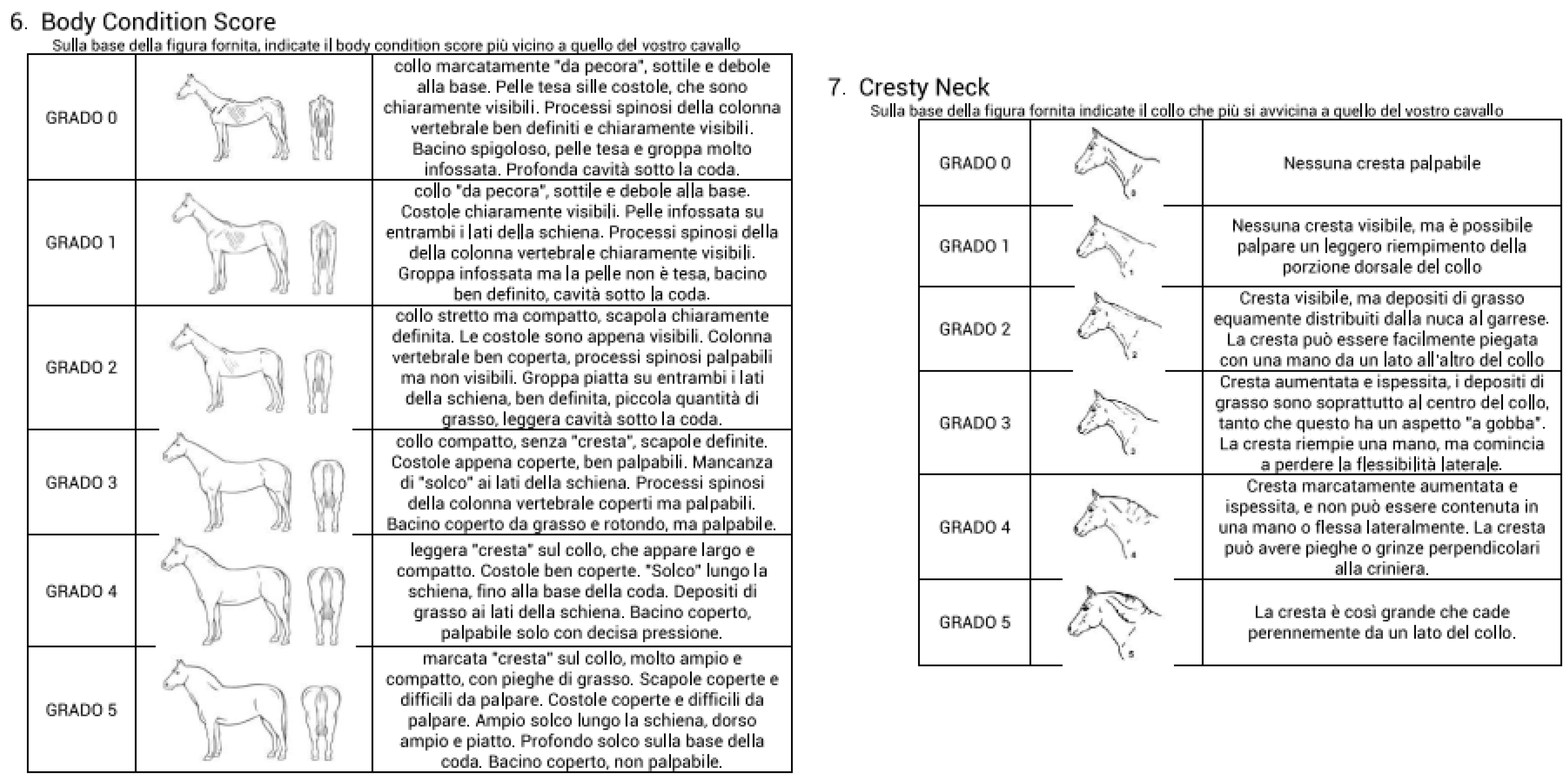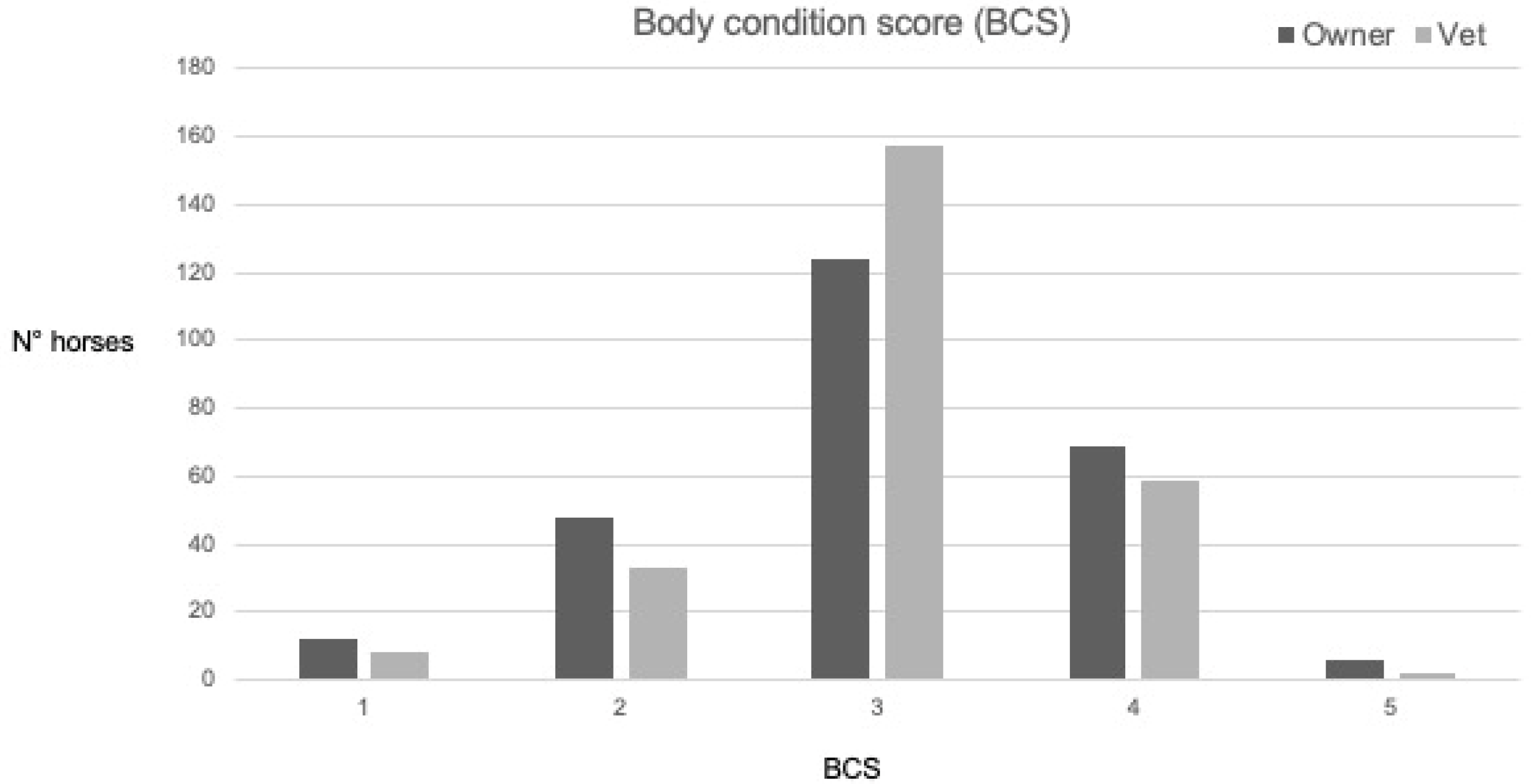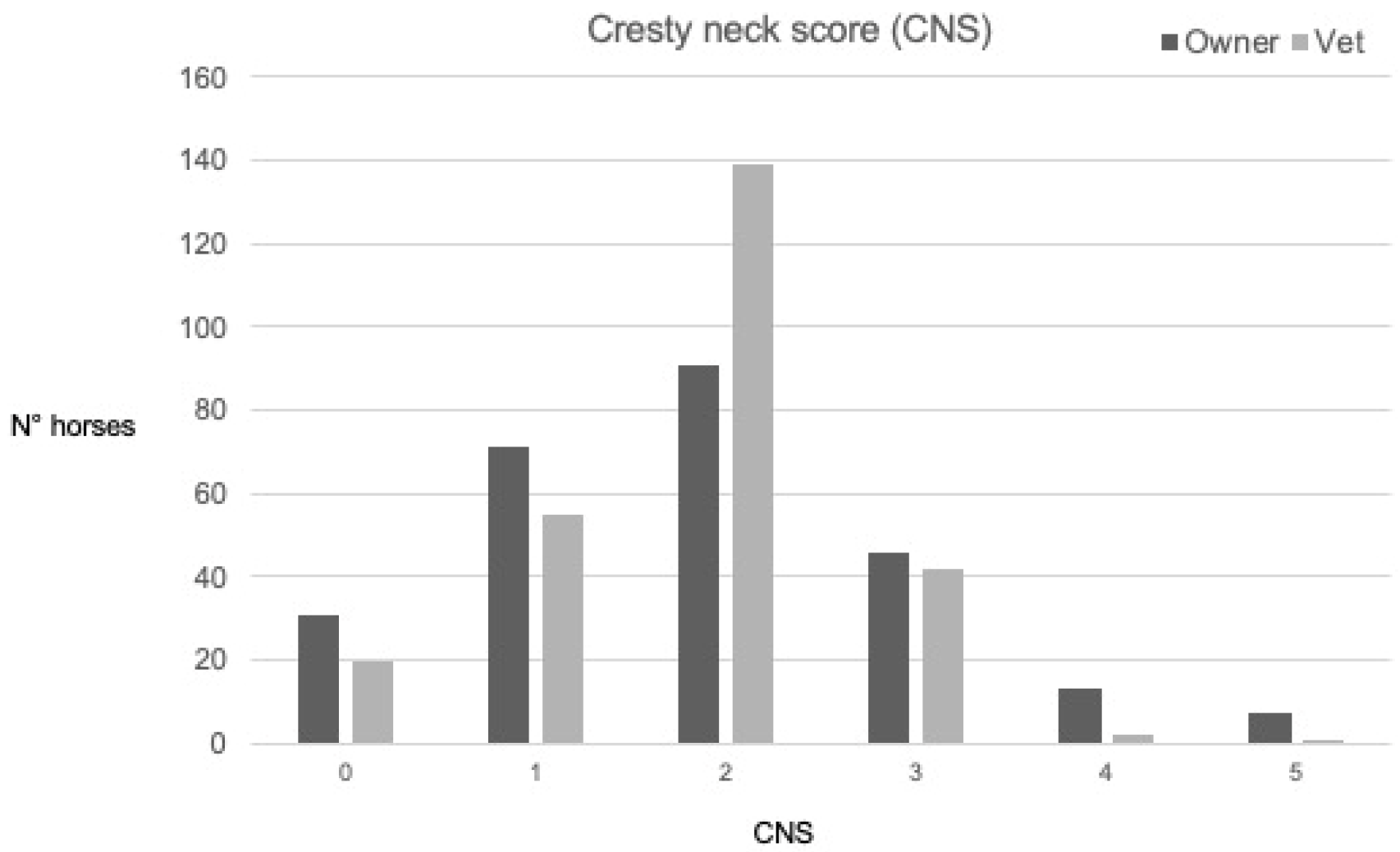Are Horse Owners Able to Estimate Their Animals’ Body Condition Score and Cresty Neck Score?
Abstract
Simple Summary
Abstract
1. Introduction
2. Materials and Methods
2.1. Horses and Management
2.2. Statistical Analysis
3. Results
4. Discussion
5. Conclusions
Author Contributions
Funding
Institutional Review Board Statement
Informed Consent Statement
Data Availability Statement
Conflicts of Interest
References
- Gentry, L.R.; Thompson, D.L.; Gentry, G.T.; Davis, K.A.; Godke, R.A.; Cartmill, J.A. The Relationship between Body Condition, Leptin, and Reproductive and Hormonal Characteristics of Mares during the Seasonal Anovulatory Period. J. Anim. Sci. 2002, 80, 2695–2703. [Google Scholar] [CrossRef]
- Cartmill, J.A.; Thompson, D.L.; Storer, W.A.; Gentry, L.R.; Huff, N.K. Endocrine Responses in Mares and Geldings with High Body Condition Scores Grouped by High vs. Low Resting Leptin Concentrations. J. Anim. Sci. 2003, 81, 2311–2321. [Google Scholar] [CrossRef]
- Gastal, M.O.; Gastal, E.L.; Spinelli, V.; Ginther, O.J. Relationships between Body Condition and Follicle Development in Mares 1. Anim. Reprod. 2018, 1, 115–121. [Google Scholar]
- Vecchi, I.; Sabbioni, A.; Bigliardi, E.; Morini, G.; Ferrari, L.; Di Ciommo, F.; Superchi, P.; Parmigiani, E. Relationship between Body Fat and Body Condition Score and Their Effects on Estrous Cycles of the Standardbred Maiden Mare. Vet. Res. Commun. 2010, 34 (Suppl. 1), 41–45. [Google Scholar] [CrossRef]
- Brooks, S.A.; Makvandi-Nejad, S.; Chu, E.; Allen, J.J.; Streeter, C.; Gu, E.; McCleery, B.; Murphy, B.A.; Bellone, R.; Sutter, N.B. Morphological Variation in the Horse: Defining Complex Traits of Body Size and Shape. Anim. Genet. 2010, 41 (Suppl. 2), 159–165. [Google Scholar] [CrossRef] [PubMed]
- Harker, I.J.; Harris, P.A.; Barfoot, C.F. The Body Condition Score of Leisure Horses Competing at an Unaffiliated Championship in the UK. J. Equine Vet. Sci. 2011, 31, 253–254. [Google Scholar] [CrossRef]
- Thatcher, C.D.; Pleasant, R.S.; Geor, R.J.; Elvinger, F. Prevalence of Overconditioning in Mature Horses in Southwest Virginia during the Summer. J. Vet. Intern. Med. 2012, 26, 1413–1418. [Google Scholar] [CrossRef] [PubMed]
- Martinson, K.L.; Coleman, R.C.; Rendahl, A.K.; Fang, Z.; McCue, M.E. Estimation of Body Weight and Development of a Body Weight Score for Adult Equids Using Morphometric Measurements. J. Anim. Sci. 2014, 92, 2230–2238. [Google Scholar] [CrossRef] [PubMed]
- Geor, R.J.; Harris, P. Dietary Management of Obesity and Insulin Resistance: Countering Risk for Laminitis. Vet. Clin. Equine Pract. 2009, 25, 51–65. [Google Scholar] [CrossRef] [PubMed]
- Shepherd, M.; Harris, P.; Martinson, K.L. Nutritional Considerations When Dealing with an Obese Adult Equine. Vet. Clin. Equine Pract. 2021, 37, 111–137. [Google Scholar] [CrossRef] [PubMed]
- Durham, A.E.; Frank, N.; McGowan, C.M.; Menzies-Gow, N.J.; Roelfsema, E.; Vervuert, I.; Feige, K.; Fey, K. ECEIM Consensus Statement on Equine Metabolic Syndrome. J. Vet. Intern. Med. 2019, 33, 335–349. [Google Scholar] [CrossRef]
- Potter, S.J.; Bamford, N.J.; Harris, P.A.; Bailey, S.R. Prevalence of Obesity and Owners’ Perceptions of Body Condition in Pleasure Horses and Ponies in South-Eastern Australia. Aust. Vet. J. 2016, 94, 427–432. [Google Scholar] [CrossRef]
- Giles, S.L.; Rands, S.A.; Nicol, C.J.; Harris, P.A. Obesity Prevalence and Associated Risk Factors in Outdoor Living Domestic Horses and Ponies. PeerJ 2014, 2, e299. [Google Scholar] [CrossRef]
- Robin, C.A.; Ireland, J.L.; Wylie, C.E.; Collins, S.N.; Verheyen, K.L.P.; Newton, J.R. Prevalence of and Risk Factors for Equine Obesity in Great Britain Based on Owner-Reported Body Condition Scores. Equine Vet. J. 2015, 47, 196–201. [Google Scholar] [CrossRef]
- McKenzie, H.C. Equine Hyperlipidemias. Vet. Clin. Equine Pract. 2011, 27, 59–72. [Google Scholar] [CrossRef]
- Fitzgerald, D.M.; Anderson, S.T.; Sillence, M.N.; de Laat, M.A. The Cresty Neck Score Is an Independent Predictor of Insulin Dysregulation in Ponies. PLoS ONE 2019, 14, e0220203. [Google Scholar] [CrossRef]
- Henneke, D.R.; Potter, G.D.; Kreider, J.L.; Yeates, B.F. Relationship between Condition Score, Physical Measurements and Body Fat Percentage in Mares. Equine Vet. J. 1983, 15, 371–372. [Google Scholar] [CrossRef]
- Carter, R.A.; Geor, R.J.; Burton Staniar, W.; Cubitt, T.A.; Harris, P.A. Apparent Adiposity Assessed by Standardised Scoring Systems and Morphometric Measurements in Horses and Ponies. Vet. J. 2009, 179, 204–210. [Google Scholar] [CrossRef]
- Carroll, C.L.; Huntington, P.J. Body Condition Scoring and Weight Estimation of Horses. Equine Vet. J. 1988, 20, 41–45. [Google Scholar] [CrossRef]
- Pollard, D.; Wylie, C.E.; Verheyen, K.L.P.; Newton, J.R. Assessment of Horse Owners’ Ability to Recognise Equine Laminitis: A Cross-Sectional Study of 93 Veterinary Diagnosed Cases in Great Britain. Equine Vet. J. 2017, 49, 759–766. [Google Scholar] [CrossRef]
- Dugdale, A.H.A.; Curtis, G.C.; Harris, P.A.; Argo, C.M. Assessment of Body Fat in the Pony: Part I. Relationships between the Anatomical Distribution of Adipose Tissue, Body Composition and Body Condition. Equine Vet. J. 2011, 43, 552–561. [Google Scholar] [CrossRef] [PubMed]
- Jaqueth, A.L.; Iwaniuk, M.E.; Burk, A.O. Characterization of the Prevalence and Management of Over-Conditioned Ponies and Horses in Maryland. J. Equine Vet. Sci. 2018, 68, 26–32. [Google Scholar] [CrossRef] [PubMed]
- Jensen, R.B.; Danielsen, S.H.; Tauson, A.H. Body Condition Score, Morphometric Measurements and Estimation of Body Weight in Mature Icelandic Horses in Denmark. Acta Vet. Scand. 2016, 58, 19–23. [Google Scholar] [CrossRef]
- Stephenson, H.M.; Green, M.J.; Freeman, S.L. Prevalence of Obesity in a Population of Horses in the UK. Vet. Rec. 2011, 168, 131. [Google Scholar] [CrossRef]
- Busechian, S.; Sgorbini, M.; Orvieto, S.; Pisello, L.; Zappulla, F.; Briganti, A.; Nocera, I.; Conte, G.; Rueca, F. Evaluation of a Questionnaire to Detect the Risk of Developing ESGD or EGGD in Horses. Prev. Vet. Med. 2021, 188, 105285. [Google Scholar] [CrossRef]
- Pearson, W.; Wood, K.; Stanley, S.; MacNicol, J. Exploring Relationships between Body Condition Score, Body Fat, Activity Level and Inflammatory Biomarkers. J. Anim. Physiol. Anim. Nutr. 2018, 102, 1062–1068. [Google Scholar] [CrossRef]
- Reed, S.M.; Bayly, W.M.; Sellon, D.C.; Divers, T.J.; Barton, M.H. Disorders of the Liver. In Equine Internal Medicine; Saunders: Philadelphia, PA, USA, 2018; pp. 843–887. [Google Scholar] [CrossRef]
- Hines, M.T. Clinical Approach to Commonly Encountered Problems. In Equine Internal Medicine, 4th ed.; Saunders: Philadelphia, PA, USA, 2018; pp. 232–310. [Google Scholar] [CrossRef]
- Sánchez, M.J.; Azor, P.J.; Molina, A.; Parkin, T.; Rivero, J.L.L.; Valera, M. Prevalence, Risk Factors and Genetic Parameters of Cresty Neck in Pura Raza Español Horses. Equine Vet. J. 2017, 49, 196–200. [Google Scholar] [CrossRef]
- Martin-Gimenez, T.; Aguirre-Pascasio, C.N.; De Blas, I. Beyond Scoring Systems: Usefulness of Morphometry Considering Demographic Variables, to Evaluate Neck and Overall Obesity in Andalusian Horses. Animal 2018, 12, 597–605. [Google Scholar] [CrossRef]



| Activity | N/259 (%) |
|---|---|
| Breeding | 63 (24.3%) |
| Driving | 10 (3.9%) |
| Endurance | 7 (2.7%) |
| Jumping | 33 (12.7%) |
| Leisure | 30 (11.5%) |
| Lessons | 58 (22.4%) |
| Racing | 34 (13.1%) |
| Show | 3 (1.2%) |
| Start training | 10 (3.9%) |
| Trekking | 8 (3.1%) |
| Western | 3 (1.2%) |
| BCS | CNS | |||||
|---|---|---|---|---|---|---|
| K | A | ρ | K | A | ρ | |
| Cohort (n = 259) | 0.32 (42.5%) | Slight | 0.53 *** | 0.35 (46.7%) | Slight | 0.66 *** |
| Age | ||||||
| Young (n = 163) | 0.25 (39.9%) | Slight | 0.36 *** | 0.31 (48.4%) | Slight | 0.60 *** |
| Adult (n = 77) | 0.38 (42.9%) | Slight | 0.70 *** | 0.39 (44.1%) | Slight | 0.73 *** |
| Geriatric (n = 19) | 0.41 (42.1%) | Moderate | 0.82 *** | 0.40 (42.1%) | Slight | 0.80 *** |
| Sex | ||||||
| Female (n = 152) | 0.33 (40.8%) | Slight | 0.53 *** | 0.40 (45.4%) | Slight | 0.72 *** |
| Gelding (n = 81) | 0.31 (45.7%) | Slight | 0.57 *** | 0.21 (49.4%) | Slight | 0.51 *** |
| Male (n = 25) | 0.27 (44.0%) | Slight | 0.42 * | 0.29 (48.0%) | Slight | 0.60 ** |
| Breed | ||||||
| Baroque (n = 10) | 0.15 (0.50%) | Slight | 0.23 NS | 0.42 (40.0%) | Moderate | 0.45 NS |
| Coldblood (n = 13) | 0.11 (53.8%) | Slight | 0.54 NS | −0.10 (69.2%) | No | −0.01 NS |
| FB (n = 126) | 0.23 (44.4%) | Slight | 0.45 *** | 0.45 (38.9%) | Moderate | 0.67 *** |
| Pony (n = 18) | 0.14 (66.7%) | Slight | 0.65 ** | 0.01 (77.8%) | Slight | 0.65 ** |
| WB (n = 92) | 0.45 (32.6%) | Moderate | 0.65 *** | 0.24 (48.9%) | Slight | 0.54 *** |
| Activity | ||||||
| Breeding (n = 63) | 0.21 (42.8%) | Slight | 0.31 * | 0.56 (33.3%) | Moderate | 0.80 *** |
| Driving (n = 10) | −0.22 (0.60%) | No | 0.00 NS | 0.10 (60.0%) | Slight | 0.46 NS |
| Endurance (n = 7) | −0.04 (57.1%) | No | 0.24 NS | 0.16 (42.8%) | Slight | 0.35 NS |
| Jumping (n = 33) | 0.45 (27.2%) | Moderate | 0.59 *** | 0.21 (48.5%) | Slight | 0.51** |
| Leisure (n = 30) | 0.39 (43.3%) | Slight | 0.68 *** | 0.30 (50.0%) | Slight | 0.74 *** |
| Lessons (n = 58) | 0.35 (46.5%) | Slight | 0.69 *** | 0.23 (55.2%) | Slight | 0.61 *** |
| Racing (n = 34) | 0.05 (41.1%) | Slight | 0.18 NS | 0.26 (44.1%) | Slight | 0.43 * |
| Show (n = 3) | NE (66.7%) | NE | 0.50 NS | NE(100%) | NE | 0.50 NS |
| Start training (n = 10) | 0.17 (0.50%) | Slight | −0.09 NS | 0.33 (40.0%) | Slight | 0.61 NS |
| Trekking (n = 8) | 0.43 (37.5%) | Moderate | 0.81 * | -0.25 (62.5%) | No | 0.14 NS |
| Western (n = 3) | 1(0.0%) | Optimal | 1.00 *** | 0.40 (33.3%) | Slight | 0.50 NS |
Publisher’s Note: MDPI stays neutral with regard to jurisdictional claims in published maps and institutional affiliations. |
© 2022 by the authors. Licensee MDPI, Basel, Switzerland. This article is an open access article distributed under the terms and conditions of the Creative Commons Attribution (CC BY) license (https://creativecommons.org/licenses/by/4.0/).
Share and Cite
Busechian, S.; Turini, L.; Sgorbini, M.; Pieramati, C.; Pisello, L.; Orvieto, S.; Rueca, F. Are Horse Owners Able to Estimate Their Animals’ Body Condition Score and Cresty Neck Score? Vet. Sci. 2022, 9, 544. https://doi.org/10.3390/vetsci9100544
Busechian S, Turini L, Sgorbini M, Pieramati C, Pisello L, Orvieto S, Rueca F. Are Horse Owners Able to Estimate Their Animals’ Body Condition Score and Cresty Neck Score? Veterinary Sciences. 2022; 9(10):544. https://doi.org/10.3390/vetsci9100544
Chicago/Turabian StyleBusechian, Sara, Luca Turini, Micaela Sgorbini, Camillo Pieramati, Lorenzo Pisello, Simona Orvieto, and Fabrizio Rueca. 2022. "Are Horse Owners Able to Estimate Their Animals’ Body Condition Score and Cresty Neck Score?" Veterinary Sciences 9, no. 10: 544. https://doi.org/10.3390/vetsci9100544
APA StyleBusechian, S., Turini, L., Sgorbini, M., Pieramati, C., Pisello, L., Orvieto, S., & Rueca, F. (2022). Are Horse Owners Able to Estimate Their Animals’ Body Condition Score and Cresty Neck Score? Veterinary Sciences, 9(10), 544. https://doi.org/10.3390/vetsci9100544





